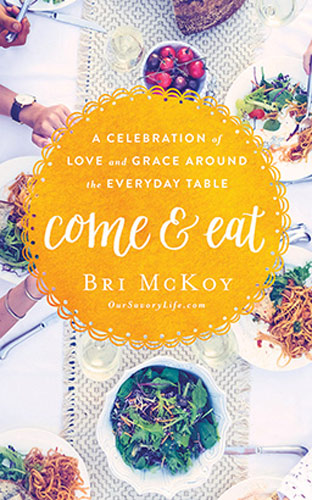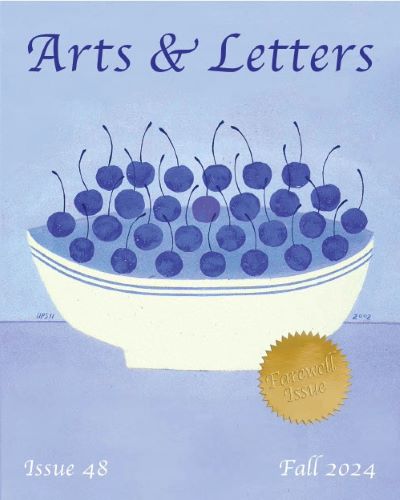Come & Eat
I was really excited to read Bri McKoy’s Come & Eat, because as a Christian who loves to eat and feed other people, a whole book about using your table as a way to “celebrate . . . love and grace” seemed like just the sort of thing I wanted.
I was really excited to read Bri McKoy’s Come & Eat, because as a Christian who loves to eat and feed other people, a whole book about using your table as a way to “celebrate . . . love and grace” seemed like just the sort of thing I wanted.
And in many ways, I was not disappointed. Every chapter was filled with Christian upbeat messages about family, communion, meekness, openness, acceptance, and love, which speaks to my own sensibilities. In fact, in my home, my wife’s and my mission plan (something many Christians have about how they will spread the word of Jesus) is entirely focused around inviting people to our home and feeding them. McKoy and her husband seem to have the same goal in mind, and to that, I related easily. In this vein, there is plenty of feel-good fare for the Christian reader, and even some poignant ideas—for example, McKoy focuses over and over again on the many times that Jesus gave his most poignant sermons and powerful examples over meals and through meals. McKoy also does something I think more Christian writers need to do: she is vulnerable in her descriptions of difficulty, doubt, and pain.
The stories in the book showcase a life that is Christianity at its best: McKoy administers to the poor and the needy, opens her home to the lonely and heartbroken, and prays earnestly when her own actions aren’t enough. It is obviously the goal of books like McKoy’s to invite readers to be better people, and in that, she clearly succeeds. In reading her book, I felt like I could do more to invite people to my table, I could do more to pray for those I can’t immediately feed, and I can do more to give and contribute to a world that is so often in pain. In one of the most powerful portions of the book McKoy reflects on the Orlando nightclub shooting, the many black men killed by police, and the divisive political climate, and invites herself and her readers not to turn away from all this pain, but to look at ourselves more deeply. She says:
Listen, if we want to make the world a better place, if we want to be the light, we need to take the issues of the world and bring them into our homes. We need to sit and think deeply about subjects like race [ . . . ] If we can sit down and do the hard work of asking the Holy Spirit to reveal our own ugliness and prejudices and then take the next step of countering those biases through the international relationships we foster at our tables, we can become lights in the darkness.
To this, a hearty “Amen!” My favorite quote along these lines was in her chapter of meekness, when she says, “We must remember that the table can be a symbol, an altar of sacrifice and humility.” Her book is filled with this wisdom and generosity of spirit.
And there are plenty of such moments in the book, with aphorisms aplenty that you might pin to Pinterest. But the other side of me, a professional reader, critic, and writer, was continually disappointed by the book’s thin argumentation and style. McKoy’s chapter structures are rather predictable and, worse, unsatisfying: She brings up a table issue or life problem, makes a food-related metaphor, shares stories from the life of Jesus, shares a story from her life, and then gives some table-related advice. It isn’t that any one of these things isn’t good or a worthy way to write a book, but rather, it often felt like she had so much to say on a subject that she couldn’t quite get it all in. Each chapter felt a little bit like sermon, a little bit like self-help book, and a little bit like personal essay, but no one form was allowed to completely develop, so I often felt that even though individual sentences were quite interesting, the connections between ideas were a little loose and unfinished, needing a stronger central thread than the current metaphor provided.
At worst, the multitude of modes made the subjects seem hastily assembled. The worst case being when, in the same chapter, a cooking tip for shredding chicken came shortly after McKoy’s reaction to hearing stories about sexually abused women in Africa. Somehow, the tips and prayers she offers in the chapter felt all too suburban, which I think even she is aware of at points in the book—that sometimes comfortable lives feel like a buffer from the real work of salvation we should be doing. Even with her acknowledging such problems, I often wondered if McKoy relied more on the emotional nature of her stories—the inspiration from Jesus’ life, the pain and cheeriness from her own, the heartbreaking stories of others—and less on any new ideas that these stories might bring up through careful scrutiny.
Even the recipes (every chapter ends with one) seem less original and more designed to please Southern California masses: Chicken white chili, sweet potato fries, cauliflower rice. And, like the ideas and focus of the book, it isn’t that we don’t all love these foods (or the idea of them), it’s just that we’ve seen them all before. Readers hoping for substantial, original thought on subjects of food and faith will close the book still hungry, even if readers looking for an inspirational book to cheer them on to better Christian service will find plenty worth nibbling on.





